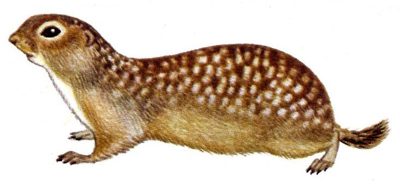Pests
Citellus (Citellus) suslicus (Gueldenstaedt 1770) - Spotted souslik.
Systematic position.
The class Mammalia, order Rodentia, suborder Sciuromorpha, family Sciuridae, subfamily Marmotinae, genus Citellus, subgenus Citellus. The species includes 5 recognized subspecies.Biological group.
Rodent pests.Morphology and biology.
Body length up to 260 mm; tail length up to 57 mm (usually 13-24 % of body length). The dorsum coloration is comparatively bright and variegated due to whitish spots on overall brown or grayish-brown background. Spots on neck, head, and at the base of tail coalesce, forming mottling. Head is not usually darker than back (from dorsal view). Dark spots above and under the eyes with intense reddish tones. Tail with clear light marginal limb. Diploid set of chromosomes: 34. Inhabits steppes (mainly feather-grass steppes), and also south forest-steppes. Prefers high places with chernozem (black earth) soils; avoids damp places with thick herbage. Colonies of "mosaic" type are usually situated on common pastures, balks, road sides, slopes of ravines adjacent to cereal and perennial grass fields or at edges of fields. Settles both in colonies and in single holes (in the north of area). Holes are of the same type as Little Souslik's holes, i.e., constant (vertical) and temporal (slanting) ones. They are compact within a colony, connected by paths.Distribution.
Spread throughout the territory of the central and western regions of the European (Russian) plain and in Polish regions contiguous to the territory of the former Soviet Union. The border of area passes along the left-bank of the Dunai and Prut rivers and through the western districts of the Lvov Region in the west; approximately to the line Rovno - Chernigov - Pochep - Karachev - Kashira - Ryazan -Arzamas . Kazan in the north; along the right-bank of the Volga river from Kazan to Saratov in the east; from the mouth of Dunai along the Black Sea coast to the mouth of Dnepr, along the right bank of Dnepr river to Dnepropetrovsk in the south, where goes over to the left bank and then further to Konstantinovka, Lugansk and further south of Millerovo, to the Volga river. Two isolated locations are known in Ukraine, in the south-western part of Volyn Region, and in Byelorussia, at the border (at the junction) of Grodno, Minsk, and Brest Regions.Ecology.
The species is mainly active during the morning and evening hours. Dates of awakening and hibernation are variable, depending on air temperature. Accumulation of fat is slower than that of Little Souslik, therefore the species doesn.t fall into "summer dormancy" (thermal numbness). Mentioned physiological features restrict settlements to drier zone, where Little Souslk lives. Hybrids with diploid set of chromosomes (34-36) are found at the junction of the natural habitats of the two species. Feeds on predominantly vegetative food, cereals mainly. Seasonal change of forage is well-defined; rodents feed on underground parts of plants in early spring, on seeds and flowers in summer, and in autumn on seeds, as main fattening forage. Does not store reserves. Quantity of females participating in reproduction varies from year to year and depends on air temperature and precipitation in different months. Average number of young animals is 7 in a brood. Sudden variations in population dynamics are not observed. Up to 70% of young animals will die by the following year. Death-rate of spotted souslik and other rodents is determined by the following main factors including deep frost penetration of soil during hibernation, late prolonged spring and soil overdamping, regular control on big squares, ploughing of virgin and long-fallow lands (main areas and habitats of rodents. reservation), high activity of predators, epizootics.Economic significance.
Harmful cereal pest. Destroys sowings of crops at all developmental stages. In some places rodents damage truck crops and protective afforestation, feeding on sown acorns and browsing young oak shoots. Due to intensification of farm industry and regular control the rodents potential harm is now greatly reduced. Natural carrier of rabbit-fever infection. Fells are used as secondary furs.Reference citations:
Gromov I.M., Bibikov D.I., Kalabukhov N.I., Meyer M.N. 1965. Terraneous Marmotinae. Fauna SSSR. Mlekopitayushchie. Moscow, Leningrad: Nauka. V. 3(2): 467. (In Russian)Gromov I.M., Erbaeva M.A. 1995. Mammals of Russia and adjacent territories. In: Aristov A.A., Baranova G.I., eds. Lagomorphs and rodents. St. Petersburg: ZIN RAN. 522 pp. (In Russian)
Lobkov V.A. 1999. Spotted souslik in North-West Black Sea Area: biology, functioning of populations. Odessa: AstroPrint. 272 p.
Tikhvinsky V.I., Sosnina E.F. 1939. Experience of Spotted souslik's ecology research by means of ecological indicators. Voprosy ekologii i biotsenologii, 7: 141-155.


